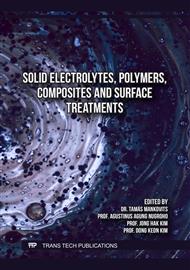[1]
U. Kalita, B. Parameswaran, N.K. Singha, Thermoplastic Elastomers, in: R. E. Kirk, D. F. Othmer, (Eds.), Kirk‐Othmer Encyclopedia of Chemical Technology, Wiley, (2022) 1-39.
DOI: 10.1002/0471238961.2008051808151204.a01.pub3
Google Scholar
[2]
N. Evode, S. A. Qamar, M. Bilal, D. Barceló, H. M. Iqbal, Plastic waste and its management strategies for environmental sustainability, Case Stud. Chem. Environ. Eng. 4 (2021) 100142.
DOI: 10.1016/j.cscee.2021.100142
Google Scholar
[3]
S. Satapathy, A. Nag, G.B. Nando, Thermoplastic elastomers from waste polyethylene and reclaim rubber blends and their composites with fly ash, Process Saf. Environ. Prot. 88 (2010) 131-141.
DOI: 10.1016/j.psep.2009.12.001
Google Scholar
[4]
Y.-H. Wang, Y.-K. Chen, D. Rodrigue, Production of Thermoplastic Elastomers Based on Recycled PE and Ground Tire Rubber: Morphology, Mechanical Properties and Effect of Compatibilizer Addition. Int. Polym. Process. 33 (2018) 525-534.
DOI: 10.3139/217.3544
Google Scholar
[5]
M. T. Hossain, M. A. Shahid, N. Mahmud, A. Habib, M. M. Rana, S. A. Khan, M. D. Hossain, Research and application of polypropylene: a review, Discov Nano. 19 (2024) 2.
DOI: 10.1186/s11671-023-03952-z
Google Scholar
[6]
R.K. Ganguly, S.K. Chakraborty, Plastic waste management during and post Covid19 pandemic: Challenges and strategies towards circular economy, Heliyon. 10 (2024) e25613.
DOI: 10.1016/j.heliyon.2024.e25613
Google Scholar
[7]
C. Bendjaouahdou, S. Bensaad, Aging studies of a polypropylene and natural rubber blend, Int. J. Ind. Chem. 9 (2018) 345-352.
DOI: 10.1007/s40090-018-0163-2
Google Scholar
[8]
A. Belhaoues, S. Benmesli, F. Riahi, Compatibilization of natural rubber–polypropylene thermoplastic elastomer blend, J. Elastomers Plast. 52 (2020) 728-746.
DOI: 10.1177/0095244319891231
Google Scholar
[9]
S.T. Nair, S.C. George, N. Kalarikkal, S. Thomas, Enhanced mechanical and thermal performance of multiwalled carbon nanotubes-filled polypropylene/natural rubber thermoplastic elastomers, New J. Chem. 45 (2021) 4963-4976.
DOI: 10.1039/d0nj05437b
Google Scholar
[10]
N. Chandran, A. Sivadas, S. Thomas, Interfacial interaction in polypropylene-natural rubber blends: role of natural rubber on morphological, rheological, and mechanical evolution, J. Polym. Res. 29 (2021) 24.
DOI: 10.1007/s10965-021-02873-8
Google Scholar
[11]
L. Saengdee, P. Daniel, T. Amornsakchai, A. Chaiyanurakkul, P. Phinyocheep, Thermoplastic vulcanizates derived from modified natural rubbers and polypropylene, Iran. Polym. J. 31 (2022) 287-299.
DOI: 10.1007/s13726-021-00998-7
Google Scholar
[12]
M.D. Shafiq, H. Ismail, The effect of epoxidized vegetable oil and phthalic anhydride as compatibilizers on properties of rubber seed shell/polypropylene composites, Iran. Polym. J. 30 (2021) 547-557.
DOI: 10.1007/s13726-021-00911-2
Google Scholar
[13]
P. Faibunchan, S. Pichaiyut, W. Chueangchayaphan, C. Kummerlöwe, N. Venneman, C. Nakason, Influence type of natural rubber on properties of green biodegradable thermoplastic natural rubber based on poly(butylene succinate), Polym. Adv. Technol. 30 (2019) 1010-1026.
DOI: 10.1002/pat.4534
Google Scholar
[14]
I. P. Mahendra, B. Wirjosentono, T. Tamrin, H. Ismail, J. A. Mendez, V. Causin, The effect of nanocrystalline cellulose and TEMPO-oxidized nanocellulose on the compatibility of polypropylene/cyclic natural rubber blends, J. Thermoplast. Compos. Mater. 35 (2022) 2146-2161.
DOI: 10.1177/0892705720959129
Google Scholar
[15]
X. Ren, C. S. Barrera, J. L. Tardiff, K. Cornish, Sustainable Epoxidized Guayule Natural Rubber, Blends and Composites with Improved Oil Resistance and Greater Stiffness, Mater. 15 (2022) 3946.
DOI: 10.3390/ma15113946
Google Scholar
[16]
S. Chuayjujit, S. Sakulkijpiboon, P. Potiyaraj, Preparation of Thermoplastic Elastomer from Epoxidised Natural Rubber and Polystyrene, Polym. Polym. Compos. 18 (2010) 139-144.
DOI: 10.1177/096739111001800303
Google Scholar
[17]
R. Zhang, Y. Zhu, J. Zhang, W. Jiang, J. Yin, Effect of the initial maleic anhydride content on the grafting of maleic anhydride onto isotactic polypropylene, J. Polym. Sci., Part A: Polym. Chem. 43 (2005) 5529-5534.
DOI: 10.1002/pola.21038
Google Scholar
[18]
N. Lopattananon, A. Walong, A. Kaesaman, T. Sakai, Mechanical, Thermal and Fire Retardant Characteristics of NR/PP/ATH Thermoplastic Vulcanizates, Walailak J. Sci. Technal. 16 (2018) 723-737.
DOI: 10.48048/wjst.2019.4436
Google Scholar
[19]
L. Dutra, M.N. de Souza, J.C. Pinto, Preparation of Polymer Microparticles through Nonaqueous Suspension Polycondensations. Part II—Effects of Operating Variables on Properties of Poly(butylene succinate), Macromol. React. Eng. 12 (2018) 1800039.
DOI: 10.1002/mren.201800039
Google Scholar
[20]
L. H. Zhu, J. F. Sheng, Z. F. Guo, X. S. Ju, S. Li, Y. F. Chen, J. Luo, Properties of Polypropylene and Surface Modified Glass-Fibre Composites, Polym. Polym. Compos. 22 (2014) 381-386.
DOI: 10.1177/096739111402200403
Google Scholar
[21]
D. Borah, S. Satokawa, S. Kato, T. Kojima, Characterization of chemically modified carbon black for sorption application, Appl. Surf. Sci. 10 (2008) 3049-3056.
DOI: 10.1016/j.apsusc.2007.10.053
Google Scholar


